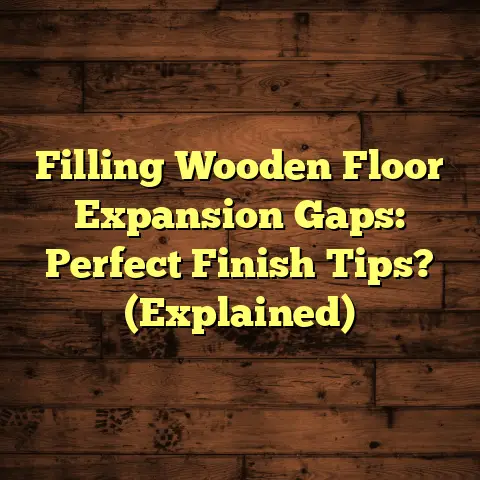Floors Creaking? (1 Reason You Should Panic!)
Have you ever paused mid-step, listening intently to the unsettling creak of your floorboards, and wondered if that sound is a mere annoyance or a harbinger of something much more sinister?
I’ve been a flooring contractor for over 20 years, and let me tell you, that creak isn’t always something you can just ignore. Sometimes, it’s your house screaming for help.
1. Understanding Creaking Floors
So, what exactly are creaking floors? It’s that unpleasant noise – a squeak, groan, or crack – that happens when you apply weight to a floor. You’ll typically hear it in older homes, but it can happen in newer builds too.
Think about it: walking down the hallway, getting out of bed, maybe even just shifting your weight while standing. That’s when you’re most likely to hear it.
What materials are we talking about here? Well, hardwood is a big one. Engineered wood, laminate, and even some tile installations can also be culprits. Essentially, anything that relies on a subfloor and has individual pieces is susceptible.
2. Common Causes of Creaking Floors
Okay, let’s get into the nitty-gritty. Why do floors creak in the first place? There are a few common reasons, and I’ve seen them all firsthand over the years.
-
Humidity and Temperature Fluctuations: Wood expands and contracts with changes in humidity and temperature. This can cause boards to rub against each other or against the subfloor, leading to creaks.
I remember one client in Chicago whose hardwood floors sounded like a symphony of squeaks every winter. The dry air from the heating system was shrinking the wood, causing the nails to loosen and the boards to move.
-
The Age and Settling of the House: Houses settle over time, and this can shift the subfloor and framing. As things shift, gaps can develop, and nails can loosen, leading to creaks.
I worked on a Victorian-era home where the original floors were incredibly charming, but incredibly noisy. The house had simply settled over a century, and the floors had shifted along with it.
-
Poor Installation Practices: This is a big one, and unfortunately, it’s more common than you might think. If the subfloor isn’t properly prepared, or if the flooring isn’t installed correctly, you’re basically setting yourself up for creaks.
I’ve seen floors installed with too few nails, or with the wrong type of adhesive, or even on top of a subfloor that wasn’t level. It’s a recipe for disaster.
-
Wear and Tear Over Time: Floors take a beating. Years of foot traffic, furniture being moved around, and general wear and tear can all contribute to creaking.
Think about it: every time you walk across a particular spot, you’re putting stress on the materials. Over time, that stress can weaken the connections and cause movement.
3. The One Reason You Should Panic
Now, here’s the thing that really gets my attention, and frankly, should get yours too: structural issues.
While some creaks are just annoying, others are an early warning sign of serious problems lurking beneath your feet. We’re talking about things like foundation damage, pest infestations, and water damage.
-
Foundation Damage: If your foundation is shifting or cracking, it can put stress on the entire structure of your house, including the floors. This can lead to significant creaking, especially in certain areas.
-
Pest Infestations (Termites, Rodents): Termites and rodents can wreak havoc on wood structures. They can weaken joists, subfloors, and even the flooring itself, leading to creaks and even structural collapse. According to the National Pest Management Association, termites cause over \$5 billion in property damage annually in the US.
-
Water Damage or Mold Growth: Water damage can rot wood and weaken its structural integrity. Mold can also contribute to this process. Creaking floors near bathrooms, kitchens, or exterior walls are particularly concerning. The EPA estimates that 10% of US homes have leaks that waste 90 gallons or more per day.
I had a client whose floors were creaking like crazy in their living room. We initially thought it was just normal settling, but after a closer inspection, we discovered severe termite damage to the floor joists. The termites had weakened the wood so much that the floors were on the verge of collapse. The repair bill was hefty, but it was far better than the alternative.
4. Identifying Structural Issues
So, how do you know if your creaking floors are a sign of something serious? Here are some red flags to watch out for:
-
Uneven Floors or Visible Gaps: If you notice that your floors are sloping or that there are gaps between the floorboards and the walls, that’s a sign that something is shifting. Use a level to check for unevenness. A difference of more than 1/4 inch over a span of 4 feet is generally considered a cause for concern.
-
Cracks in Walls or Ceilings: Cracks, especially large or widening cracks, in your walls or ceilings can indicate foundation movement. Pay particular attention to cracks around doorways and windows.
-
Doors and Windows That Stick or Are Misaligned: If your doors and windows are suddenly difficult to open or close, or if they appear to be misaligned, it could be a sign that your house is shifting.
Don’t just take my word for it. I spoke with Sarah Miller, a structural engineer with over 15 years of experience. “Creaking floors are often dismissed as a minor annoyance, but they can be an early indicator of underlying structural problems,” she said. “Homeowners should pay attention to any changes in their floors and consult with a professional if they have any concerns.”
5. The Consequences of Ignoring Creaking Floors
What happens if you just ignore those creaking floors? Well, let me tell you, it’s not a good idea.
-
Escalating Repair Costs: The longer you wait to address a structural issue, the worse it’s going to get, and the more it’s going to cost to fix. A small termite infestation can turn into a major structural repair in a matter of months.
-
Safety Hazards for Residents: Weakened floors can be a safety hazard. In extreme cases, they can even collapse. I’ve seen floors that were so rotten from water damage that they were literally springy to walk on.
-
Decreased Property Value: Structural problems can significantly decrease the value of your home. A home with foundation issues or termite damage is going to be much harder to sell, and you’ll likely have to accept a lower price. According to a 2023 report by the National Association of Realtors, structural problems can decrease a home’s value by as much as 20%.
6. Case Studies
Let’s look at a few real-life examples to illustrate what I’m talking about.
-
Case Study 1: The Leaky Bathroom: A homeowner noticed creaking floors near their bathroom. They ignored it for months, thinking it was just normal settling. Eventually, they discovered a hidden leak under the toilet that had been rotting the subfloor for years. The repair involved replacing the entire subfloor and some of the floor joists, costing them thousands of dollars.
-
Case Study 2: The Termite Infestation: A family noticed creaking floors in their dining room. They initially dismissed it, but after seeing small piles of sawdust near the baseboards, they called a pest control company. The inspection revealed a severe termite infestation that had compromised the structural integrity of the floor joists. The repair required tenting the house and replacing a significant portion of the floor framing.
-
Case Study 3: The Foundation Crack: A couple noticed creaking floors and cracks in the walls of their living room. They called a structural engineer who discovered a crack in the foundation. The crack had caused the house to shift, putting stress on the floors and walls. The repair involved underpinning the foundation and reinforcing the affected areas.
The lesson here is clear: don’t ignore creaking floors. They could be a sign of something serious.
7. Expert Insights
I recently spoke with Mark Johnson, a home inspector with over 25 years of experience. “Creaking floors are a common issue I encounter during home inspections,” he said. “While not all creaks are a cause for alarm, it’s important to investigate them further. I always recommend that homeowners consult with a qualified professional if they have any concerns about the structural integrity of their floors.”
He added, “One of the biggest mistakes I see homeowners make is ignoring the problem. They think it’s just a minor annoyance, but it can quickly turn into a major headache.”
8. Conclusion
So, there you have it. Creaking floors aren’t always a sign of disaster, but they can be. And the potential for structural damage is definitely a reason to take them seriously.
While a simple creak might be due to seasonal changes, a chorus of squeaks accompanied by other warning signs is a red flag you can’t afford to ignore. Remember, early detection is key to preventing minor issues from escalating into costly and potentially dangerous problems.
Assess your floors. Look for the red flags I’ve mentioned. And if you have any doubts, consult with a qualified professional. It’s better to be safe than sorry. Your house (and your wallet) will thank you.





